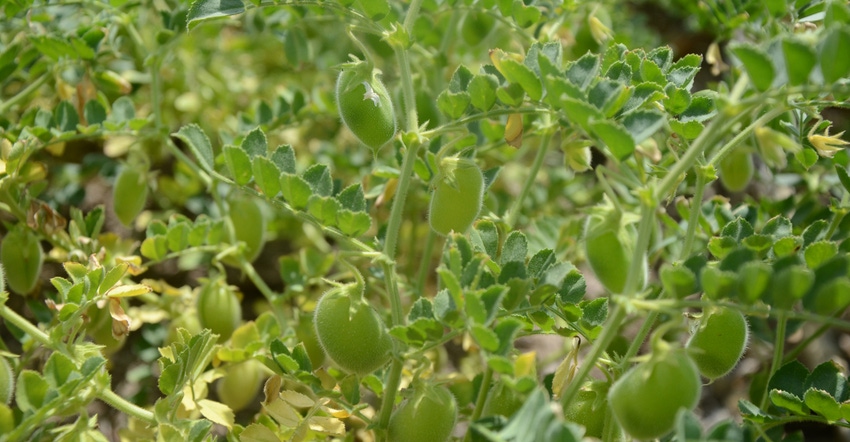November 6, 2018

Field peas and chickpeas are pulse crops often grown as a fallow replacement in dryland cropping systems in western Nebraska, including wheat-fallow or wheat-corn-fallow rotations. Although the most dominant cropping system is no-till, several farmers have observed that tillage before planting produced better yields of field peas.
Possible reasons for increased yields are earlier and more uniform emergence and canopy development, better weed suppression, extended flowering (reproductive) periods, and uniform maturity and drydown at harvest.
A study at the University of Nebraska's Stumpf International Wheat Research Center near Grant in 2018 evaluated the effects of tillage on germination patterns and grain yield for three pulse crop varieties: Frontier (chickpea), Orion (chickpea) and Durwood (yellow field pea).
A secondary objective was to develop a predictive emergence model based on the accumulation of heat units or growing degree days above a minimum-base threshold value. This model could then be used to predict emergence in other areas of Nebraska where field peas and chickpeas are grown.
The predominant soil type in the study area was Kuma silt loam, and the previous crop in rotation was corn. The entire study area was sprayed with Spartan Elite (sulfentrazone and S-metolachlor) on March 11, and tillage blocks were disked on March 14 using a heavy disk. Prior to planting, the chickpea seed was treated with a seed fungicide (Obvious), and field pea and chickpea seed were inoculated with full rates of liquid and peat inoculants (Cell-Tech).
The field pea variety Durwood was planted on March 14 at 350,000 seeds per acre using a 20-foot Crustbuster no-till box drill with 7.5-inch row spacing. The chickpea varieties Frontier and Orion were planted on March 23 at 220,000 seeds per acre in 15-inch rows using two passes of an eight-row John Deere planter.
Durwood field peas were harvested on July 20. The chickpeas were desiccated using a generic paraquat on Aug.10, and were harvested on Aug. 17.
Boost to germination, yield
Overall germination of both field peas and chickpeas was slow in 2018, which can be attributed to early planting (mid-late March) in combination with one of the coolest and wettest springs on record. The research area received precipitation from two snowstorms in April, and crops didn't start germinating until late April to early May (36 to 46 days after planting).
In this study, tillage had a positive impact on germination. The germination started, progressed and finished earlier in tillage treatments, regardless of the pulse crop variety. For example, the Durwood yellow field pea plot germinated at 10%, 50% and 90% at 46, 49 and 54 days after planting, respectively. This was four, two and three days earlier than 10%, 50% and 90% germination in the no-till blocks, respectively.
Two chickpea varieties showed similar trends in germination. Frontier and Orion chickpea finished germinating (90% germination) six and three days later in no-till treatments. Frontier under no-till was the last one to germinate on May 10.
Earlier germination in tillage treatments can be attributed to warmer soil conditions — apparent in differences in GDD accumulation. The GDD base temperatures varied between pulse crop varieties and were 41degrees F, 43 degrees, and 32 degrees for Orion (chickpea), Frontier (chickpea) and Durwood (yellow field pea), respectively. These predictive models suggest that field peas and chickpeas started to germinate at lower soil temperatures than previously thought (chickpeas at 45 degrees, field peas at 40 degrees).
Meanwhile, tillage also increased yield in these pulse crop varieties. Although yields weren't significantly different between tillage treatments, Frontier and Orion chickpea yielded 32 and 40 bushels per acre in tillage compared to 23 and 33 bushels per acre in the no-till treatment. Durwood yellow field peas yielded 40 bushels per acre under tillage — a 12-bushel-per-acre yield increase over the no-till treatment, which yielded 28 bushels per acre.

TILLAGE EFFECTS: Regression parameters (Equation 1) for the effects of tillage treatments on pulse crop germination and day of year (DOY), days after planting (DAP), date, and GDD accumulation at 10%, 50% and 90% germination. *Growing degree day (GDD) base temperatures for germination were estimated across tillage treatments for each pulse crop and variety.

Does this mean pulse growers should always use spring tillage before planting? In this case, spring tillage appeared to result in faster germination and higher yields. However, keep in mind the 2018 growing season saw above-average rainfall and cooler-than-normal conditions early on.
Researchers involved in the study caution farmers to carefully examine this practice on their fields, especially when pulse crops are grown on lighter soils and in dryer conditions.
Partial funding for this research was provided by the Nebraska Environmental Trust. This report comes from UNL CropWatch.
You May Also Like




